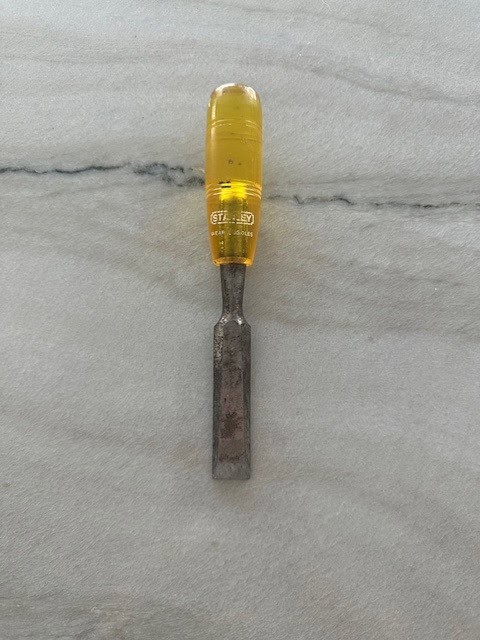A chisel is a hand tool used for cutting, carving, or shaping hard materials such as wood, metal, or stone. It consists of a sharp blade attached to a handle, which can be made of wood, plastic, or metal. The blade is typically beveled and can be struck with a mallet or pushed by hand to remove small pieces of the material. Chisels are essential tools in woodworking, metalworking, and masonry, offering precision and control in various tasks, from roughing out shapes to fine detailing.
History of the Chisel
The chisel has a long and storied history, dating back thousands of years to ancient civilizations. Early chisels were made from stone and bone, used primarily by craftsmen to carve wood, stone, and other materials. As metallurgy advanced, chisels evolved to be made from bronze and later iron, allowing for greater durability and sharper edges. Throughout history, chisels have been used in a wide range of applications, from creating intricate wood carvings in ancient temples to shaping stone blocks in monumental architecture. The basic design of the chisel has remained largely unchanged, a testament to its effectiveness and versatility.
Different Types of Chisels
- Bevel-Edge Chisel
Used for fine woodworking, especially for cutting joints like dovetails. - Mortise Chisel
Designed for cutting deep, narrow mortises in wood. - Paring Chisel
A long, thin chisel used for delicate, precise shaving of wood. - Firmer Chisel
A general-purpose chisel with a thicker blade, ideal for heavy-duty work. - Butt Chisel
Shorter than other chisels, used in tight spaces. - Cold Chisel
Made of hardened steel, used for cutting metal. - Stone Chisel
Designed for shaping and carving stone, often with a blunt edge. - Corner Chisel
Used for cutting sharp internal corners in woodwork.
Key Features of a Chisel
- Blade Material: High-carbon steel or alloy steel for durability and sharpness.
- Handle: Ergonomically designed for a comfortable grip, made from wood, plastic, or metal.
- Bevel: The angle of the blade’s edge, crucial for determining the chisel’s cutting performance.
- Length: Varies depending on the type, with longer chisels offering greater reach and control.
- Hardness: The hardness of the blade, ensuring it maintains a sharp edge during use.
Choosing the Right Chisel
Selecting the right chisel depends on the specific task at hand. For fine woodworking, a set of bevel-edge chisels is ideal, as they offer precision for tasks like cutting dovetail joints. If you’re working on heavy-duty tasks such as creating mortises, a firmer or mortise chisel would be more appropriate due to their thicker, more robust blades. For metalwork, a cold chisel is essential, while stone chisels are necessary for masonry work. Always consider the material you will be working with and the type of cuts you need to make when choosing a chisel.
Chisel Recommendations
Proper Use and Techniques
To use a chisel effectively, it’s crucial to hold the tool correctly and apply the right amount of force. Start by holding the chisel with the bevel side facing the material, then either push the chisel by hand for fine control or strike it with a mallet for more forceful cuts. Always work along the grain when chiseling wood to prevent splitting. For delicate work, such as paring, use a light, controlled push, while heavier tasks like mortising require more force. Practice on scrap material to refine your technique before working on your main project.
Maintenance and Care
Proper maintenance of your chisels ensures they remain sharp and effective. Regularly sharpen the blade using a whetstone or sharpening guide, keeping the bevel angle consistent. After use, wipe the blade clean and apply a light coat of oil to prevent rust. Store chisels in a dry place, preferably in a tool roll or box to protect the blades from damage. Periodically check the handles for any cracks or looseness, and repair or replace them as needed to ensure safe operation.
Safety Tips
When using a chisel, always wear safety glasses to protect your eyes from flying debris. Ensure that your workpiece is securely clamped or held in place to prevent slipping. Use a mallet specifically designed for chiseling, as regular hammers can damage the handle. Keep your hands behind the cutting edge to avoid injury, and never force the chisel if it becomes stuck; instead, carefully remove it and reassess your technique. Always keep the blade sharp, as dull chisels require more force and are more likely to slip.
Conclusion
Chisels are indispensable tools in any DIY enthusiast’s toolkit, offering precision and control for a wide range of tasks. Whether you’re carving intricate designs, shaping wood, or cutting through metal, understanding the different types of chisels, how to choose the right one, and the proper techniques for using and maintaining them will help you achieve the best results. With proper care and attention to safety, a quality chisel can serve you well for many years.


